New York City has a problem. As local politicians have consolidated their grip on power over the past several decades, many have become increasingly prone to serving specific groups of constituents instead of overarching ideals, noble, or otherwise. The Five Boroughs are no stranger to this kind of issue, with periods of historical stagnancy well-documented. But with electoral participation at staggeringly delegitimizing lows, local leaders like Gale Brewer will easily cruise to re-election. Amidst a backdrop of surging NIMBYism that is now more than glad to co-opt the tactics of Fake News, the outlook for the next few years on election day is rather bleak, as the politics of New York’s inward-looking regressive leaders will put up far greater barriers to entry than any potential wall along the Mexican border.
To start, while the words of New York’s local politicians regarding President Trump have been vociferously critical, a look behind the curtain reveals that family ties align perfectly with the interest of specific local Democrats. Perhaps the brightest fire of well-moneyed NIMBYism has burned at 432 East 58th Street, where Gale Brewer, Dan Garodnick, and Ben Kallos have expedited a spot-rezoning to preserve views of NIMBYs in surrounding buildings, specifically The Sovereign, which Donald Trump Jr. calls home.
Lower Manhattan has been equally vulnerable. There, along the Two Bridges waterfront, Council member Margaret Chin has teamed with Brewer in an attempt to derail another 800 new units of affordable housing, which would come alongside thousands of market-rate units. The neighborhood is currently an urban no-man’s-land with ample unused space and relatively excellent access to transit, and with Extell’s One Manhattan Square already rising, it will hopefully continue changing for the better with or without self-interested meddling.
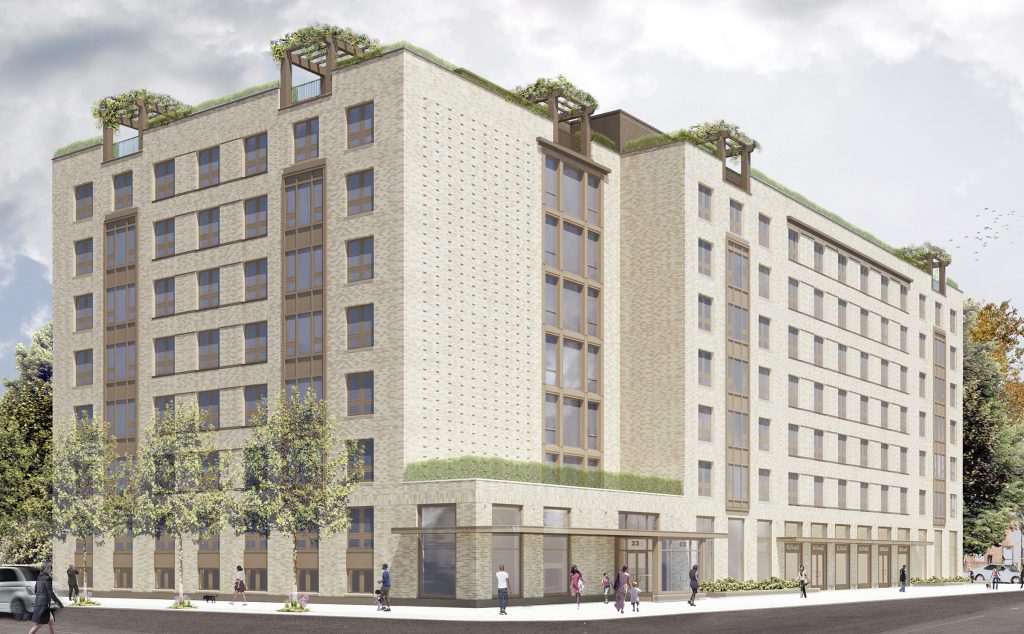
Edwin’s Place, threatened by Darlene Mealy, courtesy Robert A.M. Stern Architects
Even affordable developments have been vulnerable to power plays. Council member Darlene Mealy has said she will veto an affordable project that would deliver 125 affordable housing units to Brownsville, with a design by Robert A.M. Stern Architects promising to enhance both the site and the neighborhood.
As participation in local elections has increasingly dwindled to a shockingly-low 8%, the increasing opportunism exhibited by characters like Brewer, Chin, Gardonick, and Mealy should hardly be surprising. But unfortunately things are likely to get worse before they get better.
In good news, it seems as though DeBlasio’s housing plan may actually end up making parts of New York City substantially more affordable. In bad news, it is not because housing numbers are going to meet demand, as new permits have fallen rapidly since 2014, with the year-over-year decrease seemingly turning into an outright cliff as 2017’s last numbers trickle in.
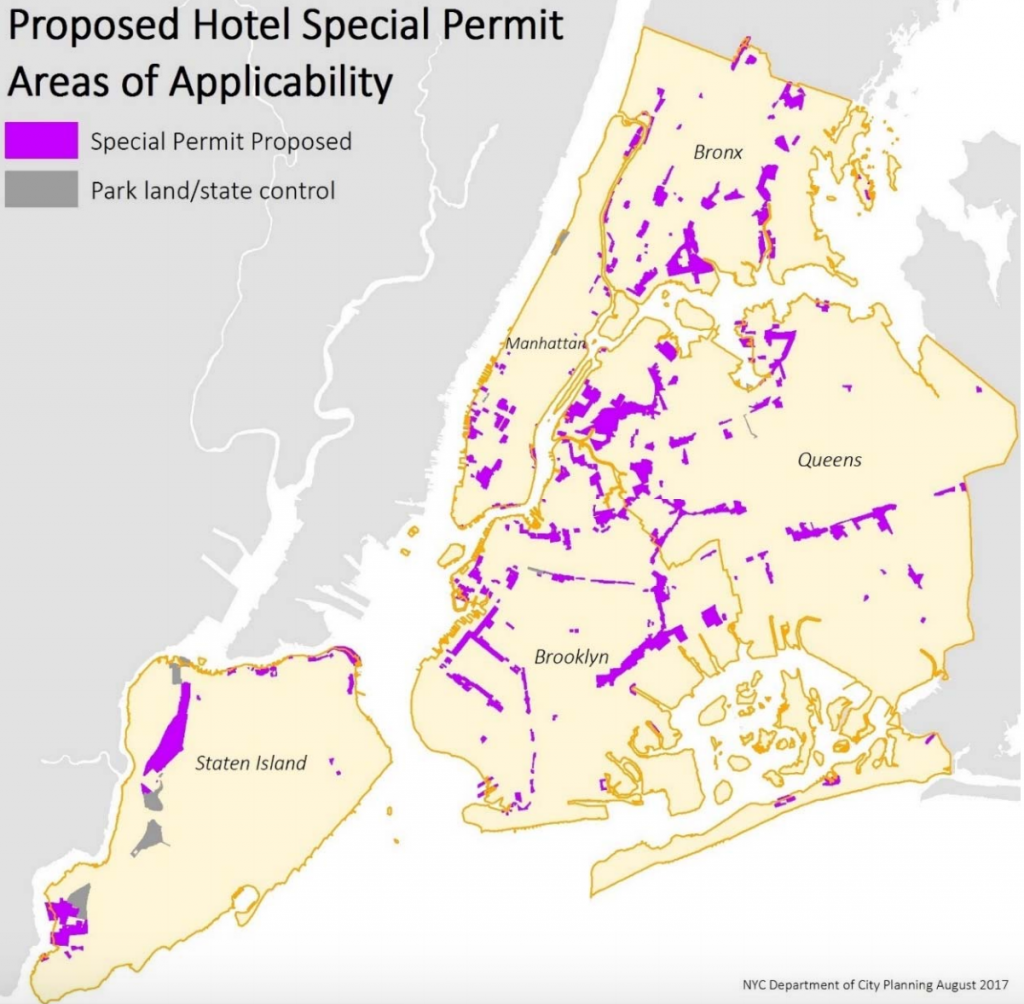
Proposed Hotel Special Permit Areas of Applicability, via City Planning
YIMBY recently covered the proposed change to M-1 zoning that will affect some new hotel developments in New York City. The idea is based on the fact that inventory is going to have ballooned well over fifty percent between 2010 and 2028. Alongside the advent of websites like AirBnB, the price of hotel rooms has already dropped substantially across the Five Boroughs, but tens of thousands of new beds are still impending.
Most crucially, many thousands of hotel beds will soon be built in the Outer Boroughs, in neighborhoods where the market is untested, and has already been proven quite soft.
If New York City’s residential building stock had increased as much as its number of hotels in recent years, the city would have ballooned past 12 million people by now. The disparity has been overwhelming, and is now jaw-dropping, but when one considers the rise in transient housing alongside the spike in transient populations, emerging evidence from several neighborhoods makes the boom make somewhat more sense.
The population count for the number of homeless in the Five Boroughs is hardly an exact science, but estimates show over 62,000 individuals, including almost 25,000 homeless children, as of this September. This was an all-time high, and these numbers are up 75% over ten years prior, according to the Coalition for the Homeless. With these numbers only including those sleeping in shelters, estimates ranging upwards of 70 to 80,000 in total would not be unreasonable.
Unfortunately, NIMBYs have essentially overwhelmed City Planning to the point where surprise hotel-to-homeless shelter conversions are the only legitimate way new beds can be built. With this workaround in mind, and on-the-ground happenings in neighborhoods like Sunnyside, Corona, and Maspeth confirming the trend, the continued rise in inventory is probably going to yield a community relations crisis of epic proportions.
Most of these Outer Borough neighborhoods with new hotels are marginally commercial or industrial to begin with. More importantly, society’s most vulnerable are typically those who end up homeless, and critical social services are necessary to ensure transient housing does not cause issues with the general community. These locations are lacking.
In this gaping chasm between NIMBY-driven housing shortages and the burgeoning homeless population falls the most sizable increase in hotel bed supply New York City has ever seen, many of which can be turned into homeless-ready-housing after nominal paperwork is completed.

The mayor delivers his State of the City speech at the Apollo Theater. photo by Edwin J Torres/Mayoral Photography Office
The outcry has already been substantial, with social media covering the outrage extensively. While the official position from City Hall is that the hotel-to-shelter trend will end by the early 2020s, the massive impending glut of hotel rooms and ramping protests from outraged local residents would argue otherwise.
Though the Mayor has done a relatively decent job of pushing for affordable housing, the backdrop of NIMBYism has worsened substantially during DeBlasio’s first four years, and uncooperative local politicians, mostly Democrats, have become increasingly emboldened in challenging new housing development, both affordable and market-rate. The culmination of regressive local politics is unfolding before all New Yorkers’ eyes, and as the homeless population continues to mushroom, the literal manifestation of leaving people out in the cold is becoming widespread physical reality.
Unfortunately, the signs for the next few years are growing darker. And while there has been substantial rhetoric on a national scale regarding a potential border wall, the barriers to entry being built by local NIMBY politicians are far more insidious, as they do not discriminate between domestic or international migrants. They filter by those who are already here, and those who are not.
With mounting internal pressures, if this reality is not already apparent to most everyone, it soon will be. The number of displaced domestic refugees is approaching levels not seen since the Dust Bowl, with the cumulative impact of events in Texas, Florida, California, and Puerto Rico leaving hundreds of thousands on the move and needing shelter. While the words of Emma Lazarus have traditionally been interpreted as having meaning to those seeking refuge from overseas, they must be equally applicable to Americans from elsewhere within this country.
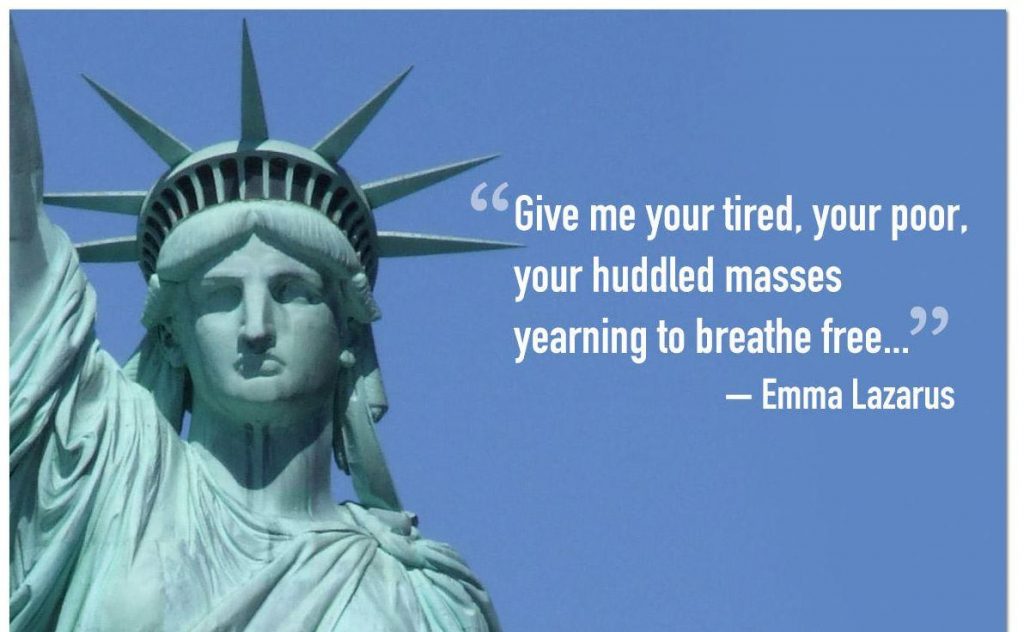
Even more importantly, unlike the time when the flow of international immigrants was fed through checkpoints at Ellis Island, there are no international borders to keep the domestically displaced out of New York City. If they want to stay, they will, and housing must be built so they are not forced to live on the streets.
As disasters continue accumulating, and the number of displaced internal migrants skyrockets, there are several questions for New Yorkers to consider on what the future will look like in another four years.
Will the number of homeless people be higher? If the answer is yes, by how much? And if the answer is “yes” and how much is “a lot,” what are the practical implications for the city’s urban areas that are already regressing to 90s-era quality of life?
Will the hotel epidemic across the Outer Boroughs continue unabated? Will City Planning strong-arm the construction of actual homeless shelters with appropriate support facilities? Or will the tens of thousands of existing and impending new beds ultimately fill the void?
Finally, what will the impact of these developments be on the real estate market in general? Can the uber-luxury segment of $20M+ condominiums continue flying off the shelves as sidewalks down below become increasingly cluttered with cardboard boxes?
Tune in come 2021 to find out. In the meantime, vote “Yes” on the Constitutional Convention option on today’s ballots, because if nothing else is clear, New York’s politics need a complete rethink — even if the means to get there are not completely clear just yet.
Subscribe to YIMBY’s daily e-mail
Follow YIMBYgram for real-time photo updates
Like YIMBY on Facebook
Follow YIMBY’s Twitter for the latest in YIMBYnews


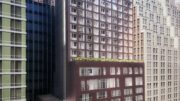

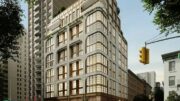

A problem performs and I have to comment and I get to know. (Thank you)
This quote shows the idiocy of the YIMBY movement: re: Two Bridges neighborhood: “The neighborhood is currently an urban no-man’s-land with ample unused space and relatively excellent access to transit…” The area is an extremely vibrant, low-income, immigrant neighborhood. Just because it doesn’t have YIMBY-approved new buildings with garbage-architecture on each block to house lower-management finance bros from Ohio doesn’t mean the area is deficient.
The vast majority of move-ins to NYC and financial bros are from the northeast or the west coast, not Ohio you kneejerk bashing cherry picking nitwit.
Nikolai oh Nikolai!
What a weird, confused, alarmist, anti-democratic and self-contradictory attempt to push your YIMBY agenda – with a false explanation of the homeless crisis and even a few exploitative quotes from Emma Lazarus thrown in for good (or deceptive) measure.
Same old stale YIMBY propaganda in ill-fitting new clothing. Still does not work.
Representative democracy always has difficulty reconciling the differing interests of its varied constituents – even with “overarching ideals”.
Obviously you disagree with some of these ideals, but then you proceed to label the whole process as illegitimate because not enough people voted for your own ideals. Do you have a better system?
Democracy entails that communities, through their political representatives have a meaningful say in the life and growth and development of their communities. Would you not want that very basic right for yourself? Do you not care about what is in your back yard? Unfortunately YIMBYS do not understand the core needs and workings of true community and communities. The ghost of Robert Moses continues to rattle and rant…
Yes we need to better address the very real crisis of homelessness, but not with your simplistic attempt to condemn people’s legitimate attempts to control their neighborhoods (and their lives) against the forces of greedy real estate developers and their YIMBY allies. Your attempt to use the issue of homelessness to smear and break the legitimate efforts of these neighborhood activists is shameful.
If being YIMBY means issuing blank checks, then it is obviously bankrupt, even though it lines the pockets of many.
May I remind you that it was these same developers who destroyed the SRO’s in New York City and which helped precipitate the homeless crisis, while at the same time making housing unaffordable to many?
While my experience has been that reflexive and self righteous local opposition to market driven real estate development is at its core selfish and too often tinged with xenophobia and class envy, I admit the prior comments by S Chaz had me agreeing for a few minutes with the idea that such forces are actually the purest form of democracy in action. That is, until he went off the rails invoking the familiar oversimplification kick me sign and hobgoblin, “greedy real estate developers”. Those folks are no more greedy by nature than the corner bodega owner, even if the high-risk, higher bar to entry nature of their chosen business field may yield greater fortunes (though actually not greater margins and all too often spectacular losses and financial ruin). The point is builders are not the problem so leave them alone. All the neighborhoods some folks don’t want changed were created by those “greedy real estate developers”. So if there is a turf war challenge in any changing urban setting, it is that economic forces in our free society work for the “haves”, rather than the “have nots”. The inevitable pitfall of the prior authors thinking is a either a tyranny of the masses or a monatany of the facistic, overly controlled eastern bloc urban blight.
Mitch, you say that “The point is builders are not the problem so leave them alone””.
My God- that is precisely the issue. We can’t “leave them alone” to do as they please!
Not in a democracy. Not anytime.
As for your so-called”inevitable pitfalls”- everything that we humans do and create is a human construct subject to change,
not something pre-ordained and written in stone – Including “economic forces”.
And therefore we can change , we can avoid the pitfalls and we can make it better. In fact we must.
It’s not that “people don’t want change” – what a simplistic an unjust condemnation on your part.
it’s that people have a right, in fact an imperative to fight , to fight against change in which they are mistreated, hurt, or ignored and deemed disposable.
It’s the very same right that I’m sure you yourself value in your own life and community, regardless of “class”, and regardless of “haves” and “have nots”. Or perhaps you LIKE being taken advantage of?
As for my using the term “greedy real estate developers” you assume that I clam that ALL developers are greedy scoundrels.
Greedy, used here, is simply an adjective used to describe the irresponsible, callous and destructive actions of some.
Obviously to apply that to all developers would be an unfounded generalization and foolish …for different people have different priorities, motivations and ways of doing things (such as working hand-in-hand with the community).
We need to better listen to each other, and to each other.s legitimate needs if if are to truly progress as a community.
As I said before, we need to embrace the true meaning of that crucial word ?community?, now more than ever.
Robert Moses must finally be put to rest.
Why would you insult residents of the Two Bridges neighborhood by calling it an “urban no-man’s-land”? I want to be charitable, but I can’t imagine any reason other than straight-up snobbery toward the lower-income residents that call it home. It’s a great, vibrant neighborhood – one that I’m quite fond of. How are you gaining local favor with remarks like that?
I’m very pro-housing, but condescending and elitist statements like this make it impossible for me to align with the YIMBY movement. It’s shameful.
It *is* an urban no-man’s-land. The towers-in-the-park style housing are inhumane and anti-urban. There are no two ways around it. The elitest thing to do is to keep these people in horribly inadequate housing (whether due to the housing itself or its format), instead of fixing the urban planning mistakes of yesteryear. There is nothing *wrong* with living there, but the neighborhood could be dramatically improved for both current and future inhabitants.
agree wholeheartedly with nikolai. he is spot on about this “neighborhood”.
Contrary to the derision of the “pro housing advocate” that it is elitist snobbery for a person to be confident that the two bridges neighborhood could be vastly improved by better, more relevant and current planning ideas, the falsely “utopian” urban planning theory which lead in the first place to the “tower in the park” zoning is outdated and has been discredited for years by sociological studies which have shown that approximately six to eight stories is the upper limit for human beings to be able to look or lean out of their windows and relate to and interact with the streetscape and the people (including their children) that happen to be down there. What a surprise! Easier visual and audible connection from the building in which folks reside to the ground below is a stabilizing, family and neighborhood friendly necessity! New York City Planners now understand this and that is why they have been creating zoning incentives for squatter, more dense, lower rise neighborhoods (ironically more like the so called “slum housing” which was wiped out in ill advised “urban renewal” schemes to make way for the futuristic low and middle income towers reflexively protected as if masterpieces by “pro housing advocates”). Even in some of the Eastern European Bloc countries, many such blocks of inhuman scaled,too tall residential towers are being demolished in favor lower rise, denser and squatter buildings. Does the “pro housing advocate believe that we cannot do better than former eastern bloc countries?? So to any pro housing advocate, I submit that more “affordable” housing towers for housing’s sake is not the ideal, rather more livable housing for peoples’sake is what needed.